Abstract
We have previously identified receptors for activated C kinase (RACKs) as components of protein kinase C (PKC) signaling. RACK1, a recently cloned 36-kDa RACK, has short sequences of homology to PKC. A possible explanation for the homologous sequences between the ligand (PKC) and its intracellular receptor (RACK1) may be that, similar to the pseudosubstrate autoregulatory sequence on PKC, there is also a pseudo-RACK1 binding site on the enzyme. If this is the case, peptides with these sequences (derived from either RACK1 or PKC) are expected to affect PKC binding to RACK1 in vitro and PKC-mediated functions in vivo. Here, we show that the PKC-derived peptide (pseudo-RACK1 peptide), but not its RACK1 homologue, modulated PKC function both in vitro and in vivo. Our data suggest that the pseudo-RACK1 peptide binds and activates PKC in the absence of PKC activators and thereby acts as an agonist of PKC function in vivo. Therefore, the pseudo-RACK1 sequence in PKC appears to be another autoregulatory site; when PKC is in an inactive conformation, the pseudo-RACK1 site interacts with the RACK-binding site. Activation of PKC exposes the RACK-binding site, enabling the association of the enzyme with its anchoring RACK. Similar pseudoanchoring sites may regulate the function of other protein kinases.
Full text
PDF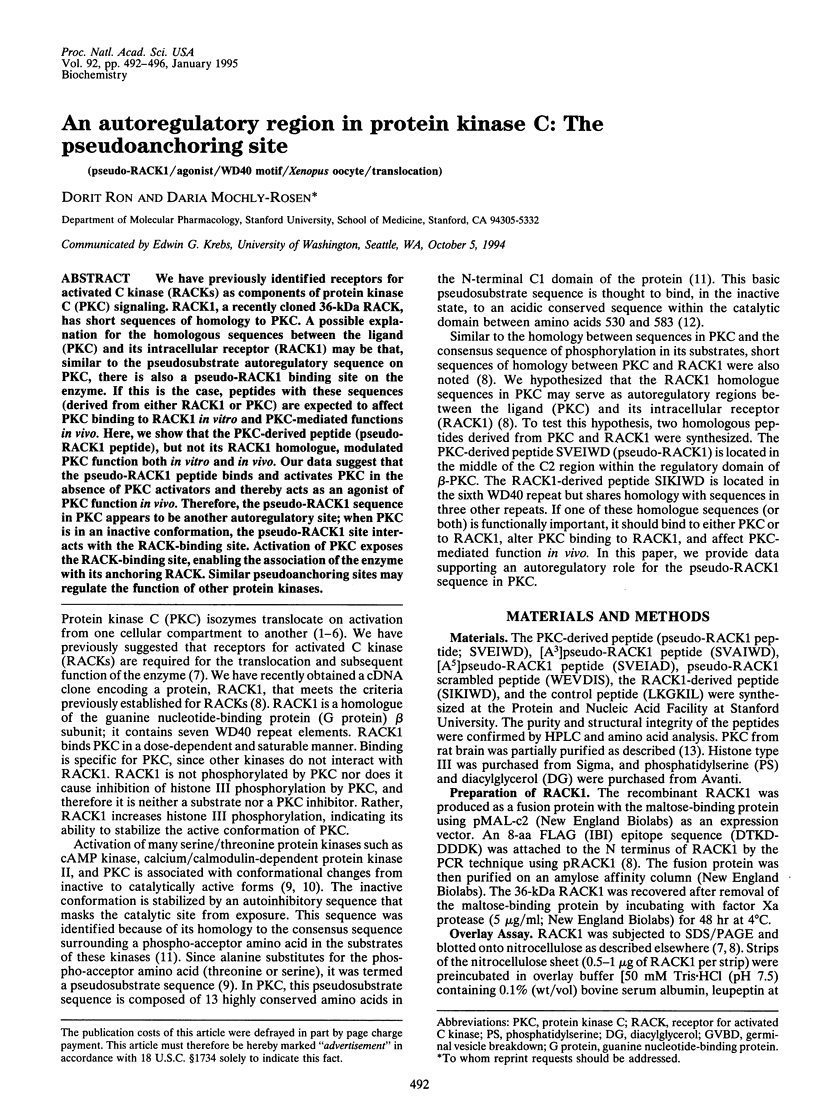
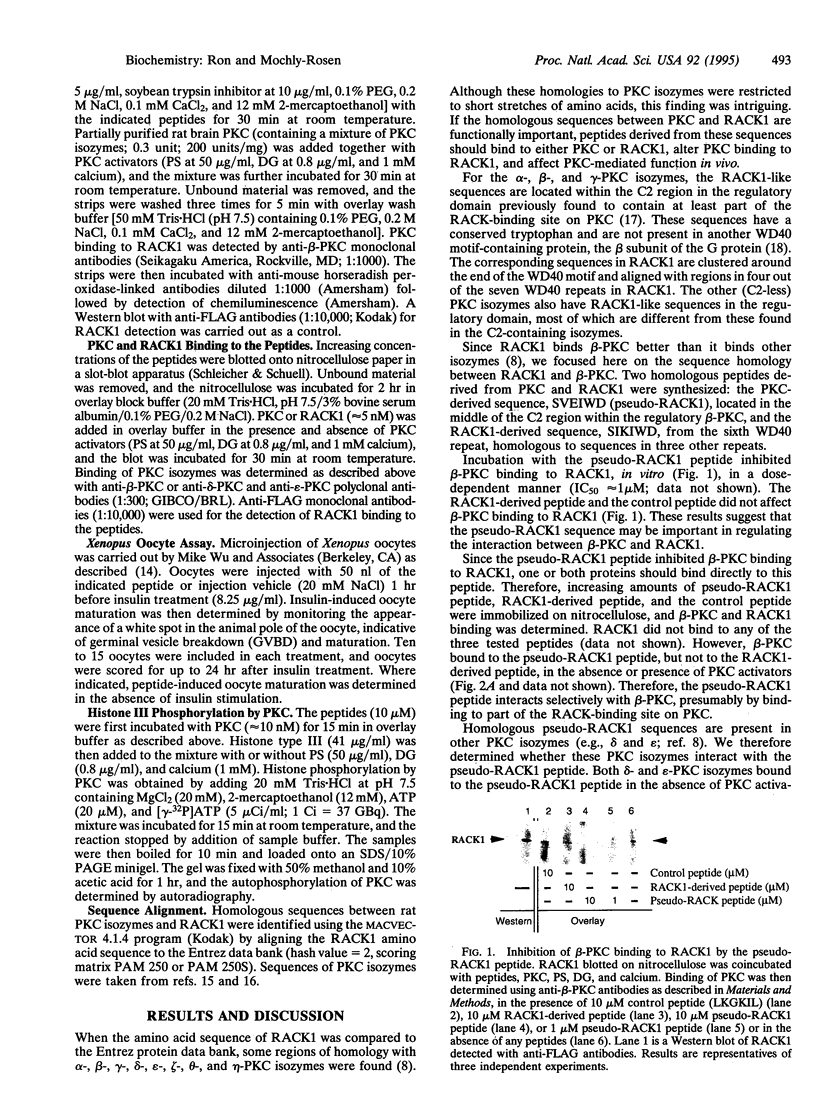
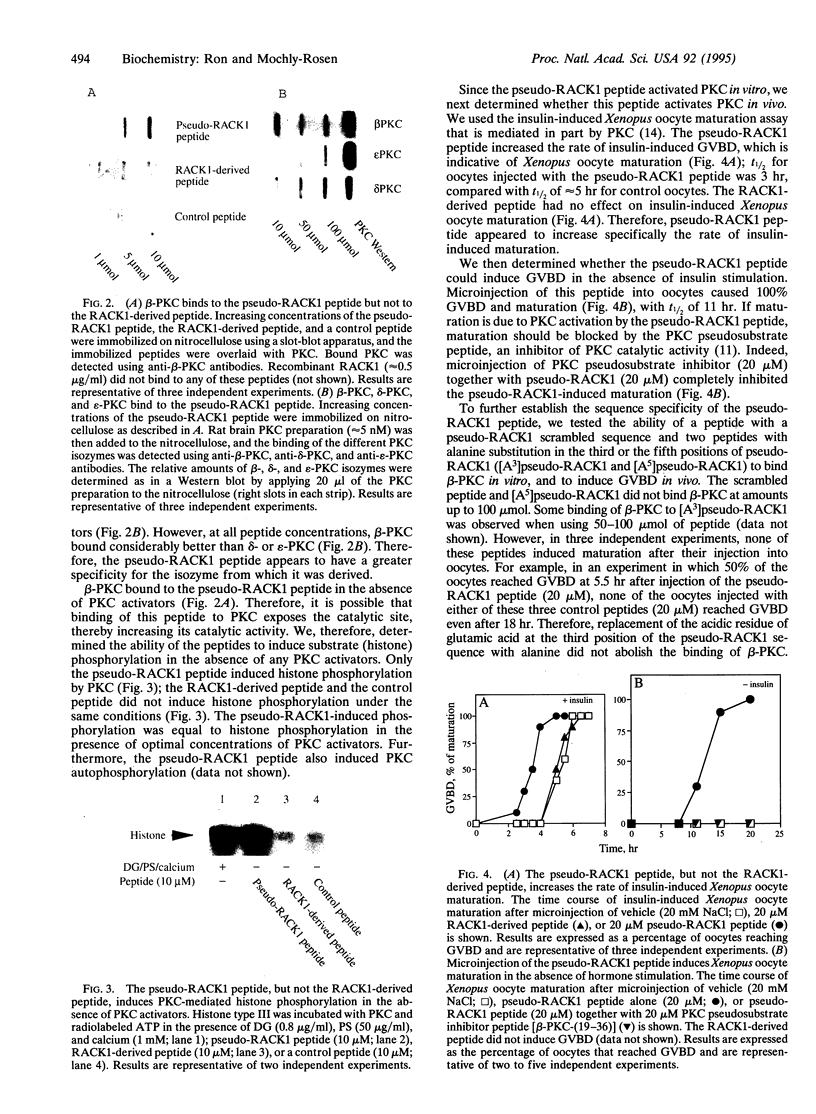
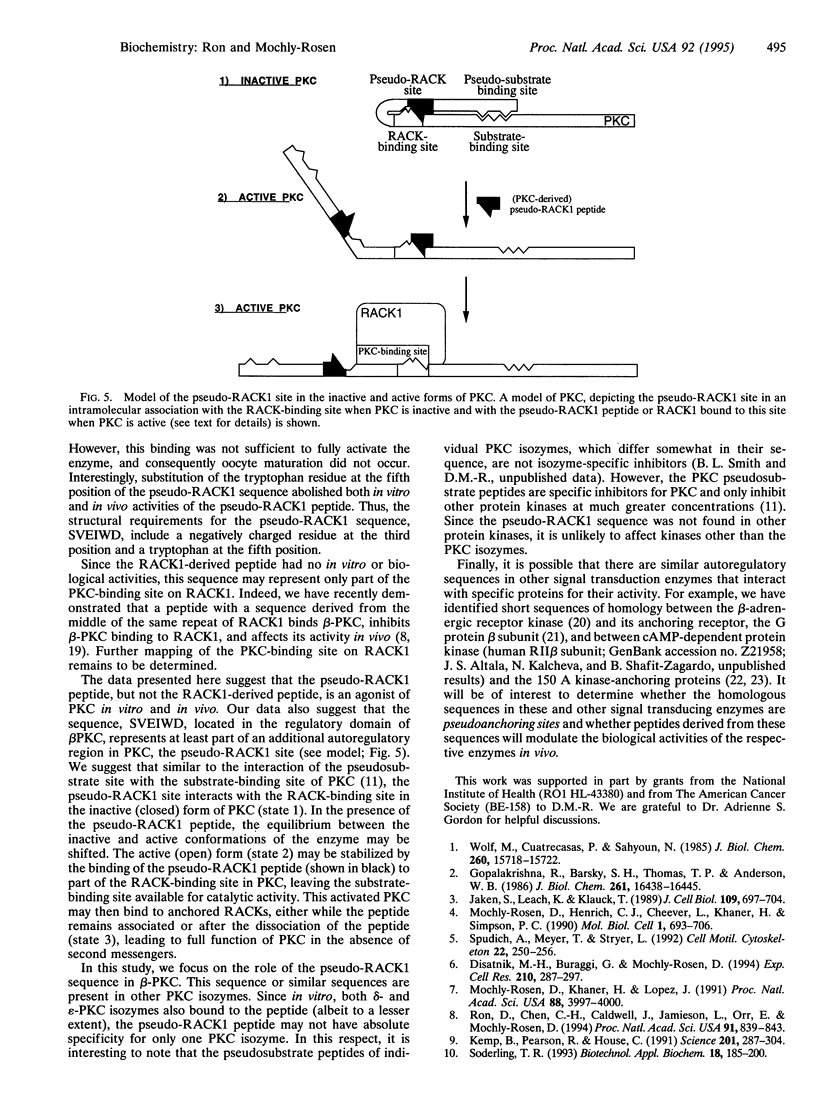
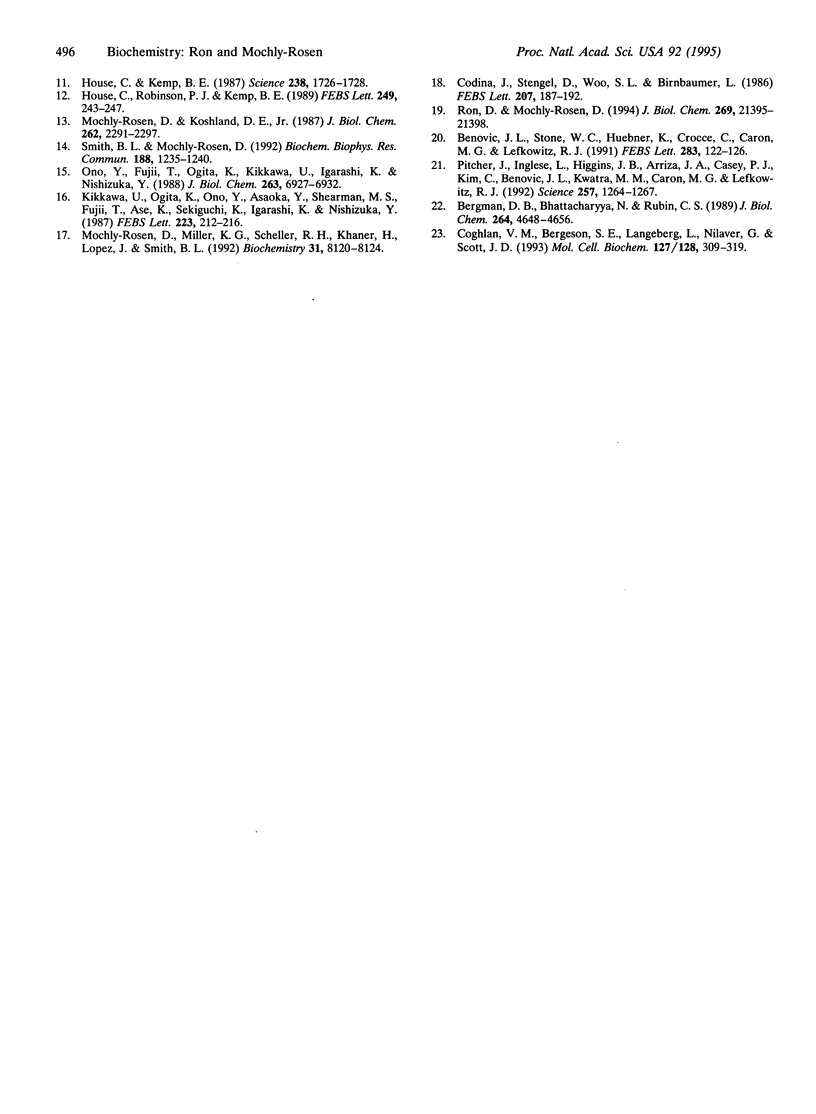
Images in this article
Selected References
These references are in PubMed. This may not be the complete list of references from this article.
- Benovic J. L., Stone W. C., Huebner K., Croce C., Caron M. G., Lefkowitz R. J. cDNA cloning and chromosomal localization of the human beta-adrenergic receptor kinase. FEBS Lett. 1991 May 20;283(1):122–126. doi: 10.1016/0014-5793(91)80568-n. [DOI] [PubMed] [Google Scholar]
- Bregman D. B., Bhattacharyya N., Rubin C. S. High affinity binding protein for the regulatory subunit of cAMP-dependent protein kinase II-B. Cloning, characterization, and expression of cDNAs for rat brain P150. J Biol Chem. 1989 Mar 15;264(8):4648–4656. [PubMed] [Google Scholar]
- Codina J., Stengel D., Woo S. L., Birnbaumer L. Beta-subunits of the human liver Gs/Gi signal-transducing proteins and those of bovine retinal rod cell transducin are identical. FEBS Lett. 1986 Oct 27;207(2):187–192. doi: 10.1016/0014-5793(86)81486-7. [DOI] [PubMed] [Google Scholar]
- Coghlan V. M., Bergeson S. E., Langeberg L., Nilaver G., Scott J. D. A-kinase anchoring proteins: a key to selective activation of cAMP-responsive events? Mol Cell Biochem. 1993 Nov;127-128:309–319. doi: 10.1007/978-1-4615-2600-1_28. [DOI] [PubMed] [Google Scholar]
- Disatnik M. H., Buraggi G., Mochly-Rosen D. Localization of protein kinase C isozymes in cardiac myocytes. Exp Cell Res. 1994 Feb;210(2):287–297. doi: 10.1006/excr.1994.1041. [DOI] [PubMed] [Google Scholar]
- Gopalakrishna R., Barsky S. H., Thomas T. P., Anderson W. B. Factors influencing chelator-stable, detergent-extractable, phorbol diester-induced membrane association of protein kinase C. Differences between Ca2+-induced and phorbol ester-stabilized membrane bindings of protein kinase C. J Biol Chem. 1986 Dec 15;261(35):16438–16445. [PubMed] [Google Scholar]
- House C., Kemp B. E. Protein kinase C contains a pseudosubstrate prototope in its regulatory domain. Science. 1987 Dec 18;238(4834):1726–1728. doi: 10.1126/science.3686012. [DOI] [PubMed] [Google Scholar]
- House C., Robinson P. J., Kemp B. E. A synthetic peptide analog of the putative substrate-binding motif activates protein kinase C. FEBS Lett. 1989 Jun 5;249(2):243–247. doi: 10.1016/0014-5793(89)80632-5. [DOI] [PubMed] [Google Scholar]
- Jaken S., Leach K., Klauck T. Association of type 3 protein kinase C with focal contacts in rat embryo fibroblasts. J Cell Biol. 1989 Aug;109(2):697–704. doi: 10.1083/jcb.109.2.697. [DOI] [PMC free article] [PubMed] [Google Scholar]
- Kemp B. E., Pearson R. B., House C. M. Pseudosubstrate-based peptide inhibitors. Methods Enzymol. 1991;201:287–304. doi: 10.1016/0076-6879(91)01026-x. [DOI] [PubMed] [Google Scholar]
- Kikkawa U., Ogita K., Ono Y., Asaoka Y., Shearman M. S., Fujii T., Ase K., Sekiguchi K., Igarashi K., Nishizuka Y. The common structure and activities of four subspecies of rat brain protein kinase C family. FEBS Lett. 1987 Nov 2;223(2):212–216. doi: 10.1016/0014-5793(87)80291-0. [DOI] [PubMed] [Google Scholar]
- Mochly-Rosen D., Henrich C. J., Cheever L., Khaner H., Simpson P. C. A protein kinase C isozyme is translocated to cytoskeletal elements on activation. Cell Regul. 1990 Aug;1(9):693–706. doi: 10.1091/mbc.1.9.693. [DOI] [PMC free article] [PubMed] [Google Scholar]
- Mochly-Rosen D., Khaner H., Lopez J. Identification of intracellular receptor proteins for activated protein kinase C. Proc Natl Acad Sci U S A. 1991 May 1;88(9):3997–4000. doi: 10.1073/pnas.88.9.3997. [DOI] [PMC free article] [PubMed] [Google Scholar]
- Mochly-Rosen D., Koshland D. E., Jr Domain structure and phosphorylation of protein kinase C. J Biol Chem. 1987 Feb 15;262(5):2291–2297. [PubMed] [Google Scholar]
- Mochly-Rosen D., Miller K. G., Scheller R. H., Khaner H., Lopez J., Smith B. L. p65 fragments, homologous to the C2 region of protein kinase C, bind to the intracellular receptors for protein kinase C. Biochemistry. 1992 Sep 8;31(35):8120–8124. doi: 10.1021/bi00150a003. [DOI] [PubMed] [Google Scholar]
- Ono Y., Fujii T., Ogita K., Kikkawa U., Igarashi K., Nishizuka Y. The structure, expression, and properties of additional members of the protein kinase C family. J Biol Chem. 1988 May 15;263(14):6927–6932. [PubMed] [Google Scholar]
- Pitcher J. A., Inglese J., Higgins J. B., Arriza J. L., Casey P. J., Kim C., Benovic J. L., Kwatra M. M., Caron M. G., Lefkowitz R. J. Role of beta gamma subunits of G proteins in targeting the beta-adrenergic receptor kinase to membrane-bound receptors. Science. 1992 Aug 28;257(5074):1264–1267. doi: 10.1126/science.1325672. [DOI] [PubMed] [Google Scholar]
- Ron D., Chen C. H., Caldwell J., Jamieson L., Orr E., Mochly-Rosen D. Cloning of an intracellular receptor for protein kinase C: a homolog of the beta subunit of G proteins. Proc Natl Acad Sci U S A. 1994 Feb 1;91(3):839–843. doi: 10.1073/pnas.91.3.839. [DOI] [PMC free article] [PubMed] [Google Scholar]
- Ron D., Mochly-Rosen D. Agonists and antagonists of protein kinase C function, derived from its binding proteins. J Biol Chem. 1994 Aug 26;269(34):21395–21398. [PubMed] [Google Scholar]
- Smith B. L., Mochly-Rosen D. Inhibition of protein kinase C function by injection of intracellular receptors for the enzyme. Biochem Biophys Res Commun. 1992 Nov 16;188(3):1235–1240. doi: 10.1016/0006-291x(92)91363-u. [DOI] [PubMed] [Google Scholar]
- Soderling T. R. Protein kinases and phosphatases: regulation by autoinhibitory domains. Biotechnol Appl Biochem. 1993 Oct;18(Pt 2):185–200. [PubMed] [Google Scholar]
- Spudich A., Meyer T., Stryer L. Association of the beta isoform of protein kinase C with vimentin filaments. Cell Motil Cytoskeleton. 1992;22(4):250–256. doi: 10.1002/cm.970220405. [DOI] [PubMed] [Google Scholar]
- Wolf M., Cuatrecasas P., Sahyoun N. Interaction of protein kinase C with membranes is regulated by Ca2+, phorbol esters, and ATP. J Biol Chem. 1985 Dec 15;260(29):15718–15722. [PubMed] [Google Scholar]





